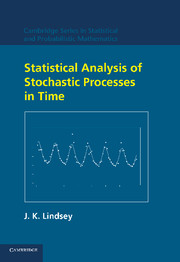Book contents
13 - Compartment models
Published online by Cambridge University Press: 03 February 2010
Summary
In Chapter 6, we studied how the event histories of individuals can be modelled as stochastic processes passing through a number of different states. A similar phenomenon occurs when a quantity of some material moves through the different parts (the states) of some system. If the system can be divided into a number of compartments (corresponding to the states in event histories), elements of the material can be assumed to move stochastically among them, possibly in both directions
In such a context, similar models to those in Chapter 6 should be applicable. However, in that chapter, we were able to observe the individual movements among compartments. Here, in contrast to event histories, I shall assume that we can only observe aggregate movement. Thus, the situation will be the same as for the growth curve models in Chapter 12: we have here a second set of phenomena where we cannot observe individual changes. However, in contrast to growth curves, the models will allow material, not to accumulate in the system, but rather to enter, flow through, and leave it.
Thus, once again, records of change in such a system will be averages of the unobservable stochastic changes of the elements involved. Generally, we shall either be interested in how the total amount of material in the system changes over time or in changes in the amount in one particular compartment of special interest. As in the case of growth curves, a second level of external stochastic disturbances will also be present.
- Type
- Chapter
- Information
- Statistical Analysis of Stochastic Processes in Time , pp. 285 - 302Publisher: Cambridge University PressPrint publication year: 2004

